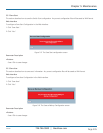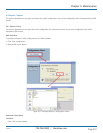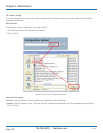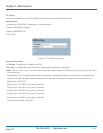
724-746-5500 | blackbox.com
Page 218
724-746-5500 | blackbox.com
SNAP: The SubNetwork Access Protocol (SNAP) is a mechanism for multiplexing, on networks using IEEE 802.2 LLC, more
protocols than can be distinguished by the 8-bit 802.2 Service Access Point (SAP) fields. SNAP supports identifying protocols by
Ethernet type field values; it also supports vendor-private protocol identifier.
SNMP: SNMP is an acronym for Simple Network Management Protocol. It is part of the Transmission Control Protocol/Internet
Protocol (TCP/IP) protocol for network management. SNMPs allow diverse network objects to participate in a network
management architecture. It enables network management systems to learn network problems by receiving traps or change
notices from network devices implementing SNMP.
SNTP: SNTP is an acronym for Simple Network Time Protocol, a network protocol for synchronizing the clocks of computer
systems. SNTP uses UDP (datagrams) as a transport layer.
SSID: Service Set Identifier is a name used to identify the particular 802.11 wireless LANs to which a user wants to attach. A
client device will receive broadcast messages from all access points within range advertising their SSIDs, and can choose one to
connect to based on pre-configuration, or by displaying a list of SSIDs in range and asking the user to select one.
SSH: SSH is an acronym for Secure Shell. It is a network protocol that allows data to be exchanged using a secure channel
between two networked devices. The encryption used by SSH provides confidentiality and integrity of data over an insecure
network. The goal of SSH was to replace the earlier rlogin, TELNET and rsh protocols, which did not provide strong authentica-
tion or guarantee confidentiality.
SSM: SSM In SyncE this is an abbreviation for Synchronization Status Message and is containing a QL indication.
STP: Spanning Tree Protocol is an OSI Layer 2 protocol that ensures a loop-free topology for any bridged LAN. The original STP
protocol is now obsolete by RSTP.
SyncE: SyncE Is an abbreviation for Synchronous Ethernet. This functionality is used to make a network “clock frequency“
synchronized. Not to be confused with real-time clock synchronized (IEEE 1588).
TACACS+: TACACS+ is an acronym for Terminal Acess Controller Access Control System Plus. It is a networking protocol that
provides access control for routers, network access servers, and other networked computing devices via one or more centralized
servers. TACACS+ provides separate authentication, authorization, and accounting services.
Tag Priority: Tag Priority is a 3-bit field storing the priority level for the 802.1Q frame.
TCP: TCP is an acronym for Transmission Control Protocol. It is a communications protocol that uses the Internet Protocol (IP) to
exchange the messages between computers. The TCP protocol guarantees reliable and in-order delivery of data from sender to
receiver and distinguishes data for multiple connections by concurrent applications (for example, Web server and e-mail server)
running on the same host. The applications on networked hosts can use TCP to create connections to one another. It is known
as a connection-oriented protocol, which means that a connection is established and maintained until such time as the message
or messages to be exchanged by the application programs at each end have been exchanged. TCP is responsible for ensuring
that a message is divided into the packets that IP manages and for reassembling the packets back into the complete message at
the other end. Common network applications that use TCP include the World Wide Web (WWW), e-mail, and File Transfer
Protocol (FTP).
TELNET: TELNET is an acronym for TELetype NETwork. It is a terminal emulation protocol that uses the Transmission Control
Protocol (TCP) and provides a virtual connection between TELNET server and TELNET client.
TFTP: TFTP is an acronym for Trivial File Transfer Protocol. It is transfer protocol that uses the User Datagram Protocol (UDP) and
provides file writing and reading, but it does not provide directory service and security features.
UDP: UDP is an acronym for User Datagram Protocol. It is a communications protocol that uses the Internet Protocol (IP) to
exchange the messages between computers. UDP is an alternative to the Transmission Control Protocol (TCP) that uses the
Internet Protocol (IP). Unlike TCP, UDP does not provide the service of dividing a message into packet datagrams, and UDP
doesn't provide reassembling and sequencing of the packets. This means that the application program that uses UDP must be
able to make sure that the entire message has arrived and is in the right order. Network applications that want to save
processing time because they have very small data units to exchange may prefer UDP to TCP.
Appendix
LGB1108A


















